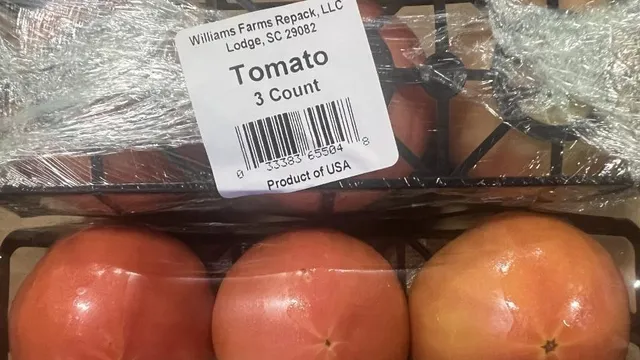
FDA raises tomato recall to highest risk after deadly contamination fears
2025-06-04 10:00- H&C Farms Label tomatoes were linked to a salmonella contamination risk, prompting a recall.
- The FDA elevated this recall to a Class I designation due to the serious health risks involved.
- Consumers are advised to discard any affected tomatoes to prevent potential illness.
Express your sentiment!
Insights
In the United States, an ongoing tomato recall has been intensified by the Food and Drug Administration (FDA) due to serious health concerns linked to potential salmonella contamination. The initial recall was announced in early May 2025 by Williams Farms Repack LLC, following the distribution of potentially contaminated H&C Farms Label tomatoes to several states including South Carolina, North Carolina, and Georgia. The affected tomatoes were sold between April 23 and April 28 in various package sizes, ranging from three-packs to large 25-pound bags. Although no illnesses were reported at the time, the FDA’s swift action indicates the severity of the issue. On May 28, the FDA assigned the recall a Class I designation, which the agency describes as situations where there is a significant probability that the use or exposure to the violative product could lead to serious adverse health consequences or even death. The tomatoes involved in this heightened recall included specific lots with codes R4467 and R4470. In addition to H&C Farms tomatoes, Ray & Mascari Inc. also announced the recall of their Vine Ripe tomatoes shortly thereafter, highlighting the broader implications of contamination across multiple distributors and brands. Despite the rising alarm, the FDA remains hopeful that consumers may not be able to find fresh tomatoes from the contaminated batch in stores. However, many consumers may have stored these tomatoes in their freezers. The salmonella bacteria are known to survive for weeks even in freezing conditions, making it crucial for customers to take urgent action by discarding any recalled products. The symptoms of a salmonella infection include diarrhea, abdominal cramps, and fever, which typically manifest within a few days post-exposure. The FDA's concerns echo a broader issue regarding food safety, particularly with salmonella outbreaks causing hundreds of thousands of infections annually in the United States. As such, consumer education on food safety practices is crucial. This situation is compounded by another food safety challenge, as cucumbers have also been recently recalled following a salmonella outbreak that affected 18 states, leaving dozens ill and increasing hospitalization rates. Regular monitoring, constant reporting, and swift recalls are integral to safeguarding public health, but the trajectory of food-related illness persists as a pressing focus for health agencies and consumers alike.
Contexts
Salmonella is one of the leading causes of foodborne illness and significantly impacts food safety across the globe. This bacterium is predominantly found in a wide range of foods, most notably in raw or undercooked meat, poultry, eggs, and untreated produce. The infectious dose can be as low as 15 to 20 cells, making it easy for consumers to become ill even with small amounts of contaminated food. Symptoms of salmonellosis, including diarrhea, fever, and abdominal cramps, typically manifest within 6 hours to 6 days after exposure, leading to significant public health concerns and economic burdens on healthcare systems and food industries alike. Public awareness and education around safe food handling, cooking, and preparation methods are critical to preventing salmonella outbreaks. In order to address the challenges posed by salmonella, various food safety initiatives have been implemented at multiple levels, ranging from farm to table. Regulatory agencies like the Food and Drug Administration (FDA) and the United States Department of Agriculture (USDA) enforce strict guidelines for food production and processing to minimize the risk of contamination. These guidelines include regular inspections, proper food storage temperatures, and the necessity of cooking meats and eggs thoroughly. Furthermore, the development of Hazard Analysis and Critical Control Points (HACCP) plans is essential for identifying potential hazards in food production and implementing control measures effectively. Continuous monitoring and adherence to these safety protocols are paramount for maintaining food safety. Advancements in technology and research play a vital role in understanding and combatting salmonella. The implementation of rapid testing methods allows food producers to identify and respond to contamination events quickly. Genetic typing techniques enable researchers to track the sources of outbreaks, facilitating targeted interventions to prevent future incidents. Moreover, the development of vaccines for livestock has emerged as a promising avenue to reduce the prevalence of salmonella at the source, thereby reducing the risk posed to humans. Education on the importance of personal hygiene, such as regular handwashing and proper kitchen sanitation, is also critical for consumer safety. Despite ongoing efforts to mitigate the risks associated with salmonella, challenges remain due to global food supply chains, which can complicate tracing and response measures. Foodborne illness outbreaks can have devastating effects, particularly for vulnerable populations such as the elderly, young children, and individuals with compromised immune systems. Enhanced collaboration among stakeholders—ranging from governments and food manufacturers to consumers—is essential to foster a collective approach towards ensuring food safety. As we continue to evolve our understanding of salmonella and improve food safety practices, it is imperative to remain vigilant and proactive in combating this persistent threat to public health.